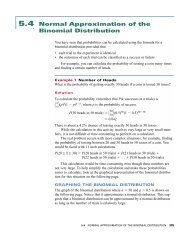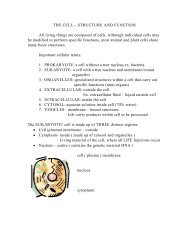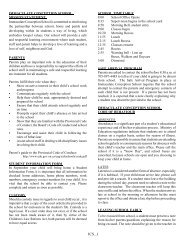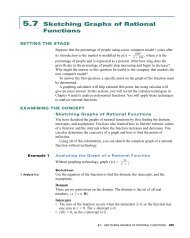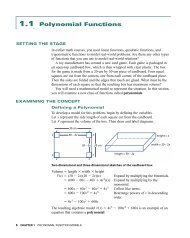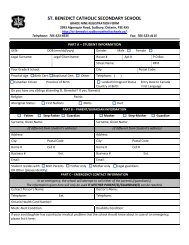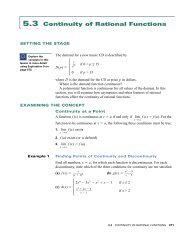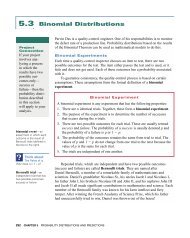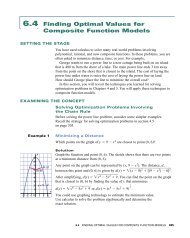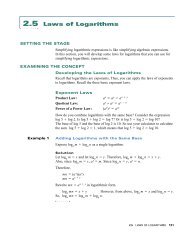1.3 Creating New Polynomial Functions: An Introduction to ...
1.3 Creating New Polynomial Functions: An Introduction to ...
1.3 Creating New Polynomial Functions: An Introduction to ...
You also want an ePaper? Increase the reach of your titles
YUMPU automatically turns print PDFs into web optimized ePapers that Google loves.
Adding, Subtracting, and Multiplying<br />
<strong>Polynomial</strong> <strong>Functions</strong><br />
For the polynomial functions f and g,<br />
• the sum is ( f g)(x) f (x) g(x)<br />
• the difference is ( f g)(x) f (x) g(x)<br />
• the product is ( fg)(x) f (x) g(x)<br />
The domain of f ± g and fg is the set of all x, for which both f and g are<br />
defined. <strong>An</strong>y x belonging <strong>to</strong> the domain of f and <strong>to</strong> the domain of g belongs<br />
<strong>to</strong> the domain of f (x) ± g(x) or f (x) g(x).<br />
EXAMINING THE CONCEPT<br />
input → output<br />
x → g(x) → f (g(x))<br />
g f<br />
input → output<br />
The Composition of <strong>Functions</strong><br />
What happens when the output of one function is the input of another<br />
You can think of a function as an input-output machine. The input set<br />
is the domain of the function, and the output set is the range of the function.<br />
In the first step of the diagram, the x is an input and g(x) is an output.<br />
In the second step, g(x) is an input and f (g(x)) is an output.<br />
Combining two functions in this way is called composition. Composition is<br />
the result of substituting the output of one function in<strong>to</strong> another. The new<br />
function is called the composite of f and g and is written f g.<br />
Example 3<br />
Determining the Equation of a Composite Function<br />
Recall the situation in Setting the Stage. Rhona earns a daily wage according <strong>to</strong><br />
R(h) 28h 22. The job site where Rhona works requires all employees <strong>to</strong><br />
become members of a union. Rhona then pays 1.5% of her daily earnings as<br />
union dues. Determine the function that represents her daily union dues.<br />
Hours Worked<br />
h<br />
1<br />
2<br />
3<br />
.<br />
.<br />
.<br />
.<br />
8<br />
R<br />
Daily Earnings<br />
R(h)<br />
50<br />
78<br />
106<br />
.<br />
.<br />
.<br />
.<br />
246<br />
Solution<br />
U<br />
Union Dues<br />
U(R(h))<br />
0.75<br />
1.17<br />
1.59<br />
.<br />
.<br />
.<br />
.<br />
3.69<br />
This situation involves two functions,<br />
Daily Earnings: R(h) 28h 22<br />
Daily Union Dues: U(R(h)) 0.015 R(h)<br />
Examine the mapping that shows how the number of<br />
hours worked per day is related <strong>to</strong> the daily union dues.<br />
The domain for Rhona’s daily earnings is the number of<br />
hours worked. But the domain for the daily union dues<br />
are her daily earnings, not the number of hours worked.<br />
In other words, the domain of the substitution function is<br />
the range of the substituted function.<br />
<strong>1.3</strong> CREATING NEW POLYNOMIAL FUNCTIONS: AN INTRODUCTION TO COMPOSITION 31



